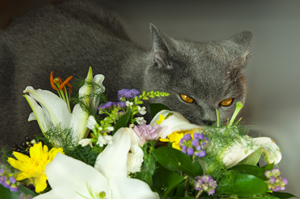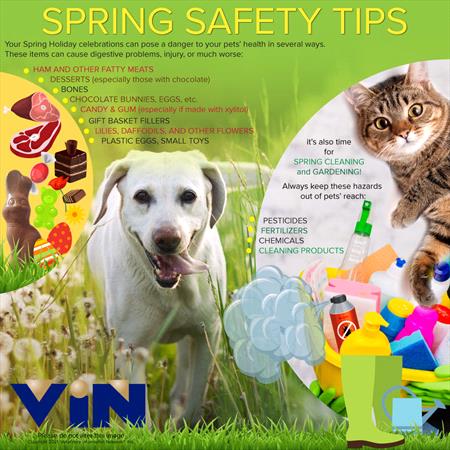cat lilies BigStock

Photo courtesy of BigStock
Easter means spring, new life and a season of chocolate, rebirth, and odd little marshmallow birds in unnatural colors. Those hollow chocolate bunnies and mushy Peeps may be somewhat gross, but they won’t kill anybody. (Remember to bite the heads off first, so they don’t suffer.)
But Easter and the associated season can also mean some pet hazards are lurking in amongst the green grass (and that green plastic grass can be a hazard to cats, so make sure they don’t play with it!).
In 20 years of veterinary ER medicine, I’ve treated literally thousands of exposures where a dog ingested chocolate, but only a handful of cases in which the dog actually became sick from it (other than some garden variety stomach and intestinal upset that is more of a risk to the carpet than the pet).
Chocolate toxicity seems to have wormed itself into our collective consciousness as the biggest risk to pets since the chicken bone. In reality, it takes a pretty large amount of milk chocolate to make a dog sick, and even more to cause life-threatening medical issues. But it can still happen.
There’s a great deal of variation between individual dogs in terms of how susceptible they are to chocolate, and the content of the toxin (known as theobromine, a cousin of caffeine) varies quite a bit between chocolates; dark chocolate is worse for dogs than milk chocolate, and unsweetened or baker’s chocolate is the most toxic. In general it takes about a pound of milk chocolate per 20 pounds of body weight to consider it a potential problem.
Signs of chocolate toxicity include fast heart rate, excitability, restlessness and, if severe, high blood pressure and seizures. It’s easily treatable, but best avoided if possible. It’s also common for dogs to experience vomiting and diarrhea after eating even small amounts of chocolate.
The most common thing we have to do for large exposures is to make them vomit up the chocolate soon after they’ve eaten it. What a mess that makes!
If your 140-pound St. Bernard eats three M&Ms, you can be pretty certain he’s gonna live another day. (Of course, if a large quantity is eaten or your dog isn’t feeling well, you should still see your family vet for advice and treatment.)
My biggest fear during these days around Easter is the lily; yes, the beautiful Easter lily, symbol of rebirth. It’s not a threat to dogs, though: cats are the ones at risk.
Every part of the plant — leaves, stems, petals — are a serious risk to your cat’s health. Even a small amount of pollen can cause life-threatening medical issues. The damage is done to the kidneys, and death can occur as soon as one to two days after ingestion.
I can remember several cases of kidney failure in some of my patients several years ago, before this was common knowledge among veterinarians, that defied explanation: indoor kitty, no exposure to the usual toxins such as antifreeze, no sign of cancer or infection. I assume now the owners had a lily in the house and that was the culprit.
Lily toxicosis is treatable if is caught very early: the cutoff for success is about 18 hours after ingestion. Beyond that point, the chance of treating kidney failure from lilies becomes quite remote. Treatment involves removing any parts of the lily that can be removed (usually through making them vomit) and then IV fluid therapy for a few days to keep the kidneys working. Lab tests tell us how successful therapy has been. There’s no way to treat this at home; they have to be in the hospital.
The American Society for the Prevention of Cruelty to Animals (ASPCA) has two great resources for pet owners regarding lily toxicity: their excellent Animal Poison Control Center (a fee for service is charged) that can help you and your vet when dealing with any kind of poisoning, and their website has info about lily toxicity as well as many other toxic plants.
Another useful resource is No Lilies for Cats, a public-service website developed by the Veterinary Information Network, the parent of VetzInsight.
Make sure that any flower arrangements you have in your home this Easter season don’t contain lilies, and ask your florist to remove lilies from any flowers you’re sending to your cat-owned friends.
Easter and spring are seasons of renewed life and rebirth. Let’s keep it that way: keep lilies away from your cats.
Spring Safety Tips

Copyright VIN 2021